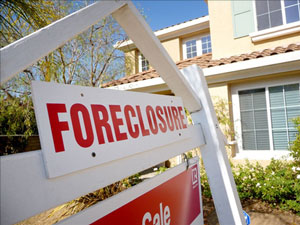-Staff Writer-

WASHINGTON, D.C. (FinalCall.com) – News that families are still struggling to pay their mortgages was no surprise to the Richardsons. They and many of their friends are one, two, three and sometimes four or more months behind on their mortgage.
“It’s hard out here. With layoffs, unemployment, reduced hours and prices going up each month it’s a toss up of what gets paid. Most times the mortgage suffers because I know they’re coming tomorrow to put us out and we have sometime to catch up,” said Larry Richardson.
“I can’t do that juggling act with the electricity or the gas bill. They will cut my stuff off and that just causes more problems. I have a wife and three kids. We’re struggling. No more cable, piano lessons are done and clothes shopping won’t happen any more this year. We’ve had to cut back.”
Many more families may join them as the latest Mortgage Bankers Association (MBA) mortgage report shows a rise in 30-day delinquencies, including an increase in late payments on prime, fixed-rate mortgages. Overall, the housing picture hasn’t changed significantly from first quarter, as one in 11 mortgage holders remains at serious risk of foreclosure (60 days delinquent or more).
“While overall mortgage delinquencies increased only slightly between the first and second quarters of this year, it is clear that the downward trend we saw through most of 2010 has stopped. Mortgage delinquencies are no longer improving and are now showing some signs of worsening,” said Jay Brinkmann, MBA’s Chief Economist.
“The good news is the continued decline in long-term delinquencies, those mortgages that are three payments or more past due. The bad news is that drop is offset by an increase in newly delinquent loans one payment past due.”
The decline in long term delinquencies may only be temporary as many loan servicers slowed down evictions while correcting problems related to robo-signing (automatic robotic signatures) and other illegal practices. Even so, more than 5.5 million U.S. homeowners are at some stage of delinquency or in the foreclosure process.
The Richardson’s fell on hard times when the Mrs. got laid off.
“Mortgage loans that are one payment, or 30 days, past due are very much driven by changes in the labor market, and the increase in these delinquencies clearly reflects the deterioration we saw in the labor market during the second quarter,” Mr. Brinkmann explained.
“Weekly first-time claims for unemployment insurance started the quarter at 385,000 but finished the quarter at 432,000. The unemployment rate started the quarter at 8.8 percent but climbed to 9.2 percent by the end of the quarter.”
While foreclosures continue to be stuck in high gear, foreclosure prevention is dragging. According to HOPE NOW’s June 2011 Loan Modification Industry Report, in the second quarter nearly 72,000 fewer homeowners received loan modifications (including trial and “proprietary” modifications outside the federal HAMP program) compared to the first quarter of this year. If this slow pace continues, the number of modifications made this year will be significantly lower than in 2010.
Added together, the MBA and HOPE NOW reports show the country is nowhere near bringing foreclosures under control. We need stronger options for preventing unnecessary foreclosures, and basic, fair ground rules in place to ensure that every troubled loan gets a real review. The alternative is more of the same: unnecessary losses that batter the entire economy.
Mortgages servicers should be required to give every mortgage holder “a good-faith review of foreclosure alternatives” before taking steps to take his or her home, Center for Responsible Lending president Michael Calhoun told Congress in July.
In testimony before the House Financial Services Committee’s Subcommittee on Financial Institutions and Consumer Credit and Subcommittee on Oversight and Investigations, he recommended that servicers be required to exhaust alternatives before starting foreclosure proceedings, disclose the numbers they use to calculate whether a mortgage holder qualifies for a loan modification rather than foreclosure and provide meaningful, third-party reviews of loan modification denials.
“Looking across states, foreclosures continued to be highly concentrated in just a few states, with five states accounting for 52 percent of the foreclosure inventory in the second quarter. The single biggest factor determining whether or not a state has a large backlog of foreclosures is whether the state has a judicial foreclosure system, meaning whether or not a foreclosure needs to go through the courts. Of the 9 states whose percentage of loans in foreclosure is higher than the national average, only one, Nevada, does not have a judicial system of foreclosure.”
“One of the reasons the percentage of loans in foreclosure in California (3.6 percent) is considerably lower than states like Florida (14.4 percent), New Jersey (8.0 percent), Illinois (7.0 percent) and New York (5.5 percent) is that California does not have a judicial foreclosure system. Therefore, as we work toward resolving the foreclosure overhang in the housing market, we should be careful to distinguish between the economic impediments to resolution and the legal impediments to resolution,” Mr. Brinkmann said.
“Some states, with Maryland as the prime example, remain burdened with elevated 90+ delinquent rates, likely due to specific government actions intended to slow foreclosure initiations in recent quarters.”












